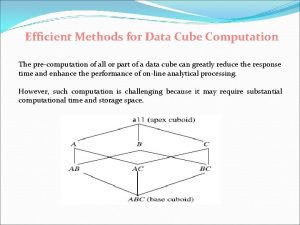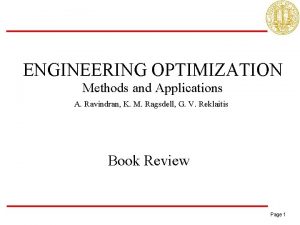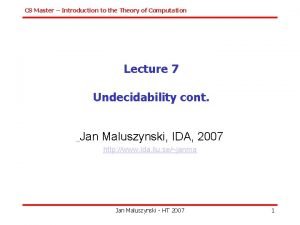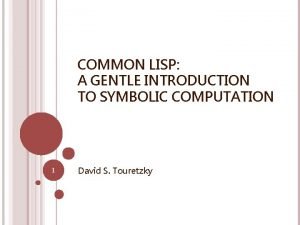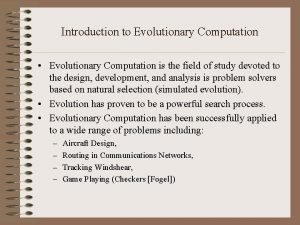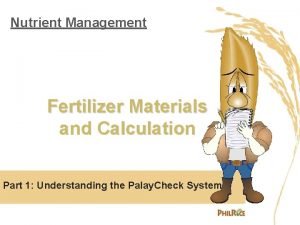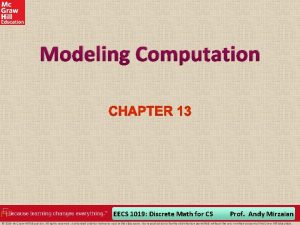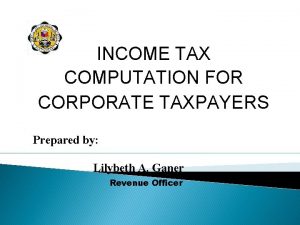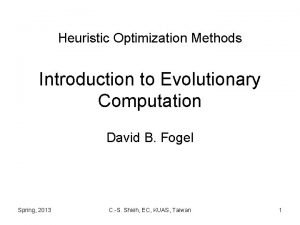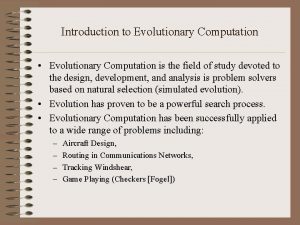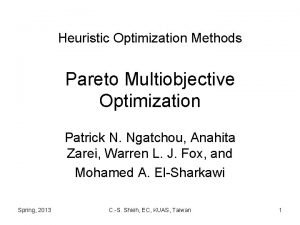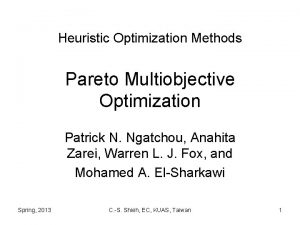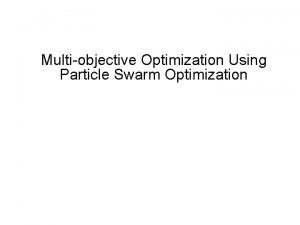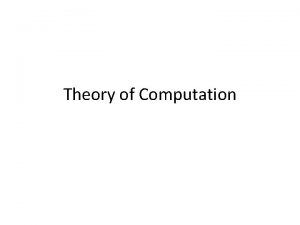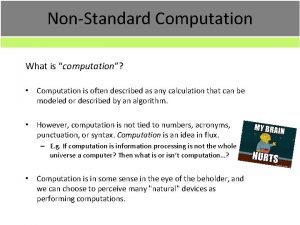Heuristic Optimization Methods Introduction to Evolutionary Computation David
















- Slides: 16

Heuristic Optimization Methods Introduction to Evolutionary Computation David B. Fogel Spring, 2013 C. -S. Shieh, EC, KUAS, Taiwan 1

1. 1 Introduction • Darwinian evolution is intrinsically a robust search and optimization mechanism. • Inspired by natural evolution, (artificial) evolutionary computation can be an effective solution to difficult optimization problems when classical approaches are infeasible. • Evolutional computation is simple, robust, flexible, … Spring, 2013 C. -S. Shieh, EC, KUAS, Taiwan 2

1. 2 Advantages of Evolutionary Computation (Heuristic Methods) • • Conceptual Simplicity Broad Applicability Outperform Classic Methods on Real Problems Potential to Use Knowledge and Hybridize with Other Methods Parallelism Robust to Dynamic Changes Capability for Self-Optimization Able to Solve Problems That Have No Known Solutions Spring, 2013 C. -S. Shieh, EC, KUAS, Taiwan 3

Limitation of EC • No guarantee on the solution quality • No guarantee on the convergence speed • Fine-tuning of control parameters Spring, 2013 C. -S. Shieh, EC, KUAS, Taiwan 4

1. 2. 1 Conceptual Simplicity • EC is conceptually simple. – Initialization – Iterating • Candidate generation • Fitness evaluation • Survival selection Spring, 2013 C. -S. Shieh, EC, KUAS, Taiwan 5

1. 2. 1 Conceptual Simplicity (cont) • Regard the evolution as an iterative process: x[t+1] s(v(x[t]) – x[]: representation of candidate solutions • Binary string, list of floating-point numbers, solution tree, … – v(): evolutionary operators for generating new candidate solutions • Crossover, mutation, local search, … – s(): selection schemes pick up survivals according to certain performance index, i. e. fitness function • Tournament, truncation, linear ranking, exponential ranking, elitist, proportional, . . . Spring, 2013 C. -S. Shieh, EC, KUAS, Taiwan 6

1. 2. 2 Broad Applicability • Evolutionary algorithms can be applied to virtually any problem that can be formulated as a function optimization task. – Discrete combinatorial problems, continuousvalued parameter optimization problems, mixed-integer problems, … • Representation, operators, and selection schemes are closely related, and ought to be carefully designed. Spring, 2013 C. -S. Shieh, EC, KUAS, Taiwan 7

1. 2. 3 Outperform Classic Methods on Real Problems • Classical approaches fail at many real-world optimization problems with – – – – nonlinear constraints, non-stationary conditions, noisy observations or random processing, other vagaries, local optima or saddle points, non-differentiable, … • EC plays its role when classical methods fail. Spring, 2013 C. -S. Shieh, EC, KUAS, Taiwan 8

1. 2. 4 Potential to Use Knowledge and Hybridize with Other Methods • It is always reasonable to incorporate domainspecific knowledge into an algorithm when addressing particular real-world problems. • Evolutionary algorithms offer a framework such that it is comparably easy to incorporate such knowledge. • Incorporating such information focuses the evolutionary search, yielding a more efficient exploration of the state space of possible solutions. • Evolutionary algorithms can also be combined with more traditional optimization techniques. Spring, 2013 C. -S. Shieh, EC, KUAS, Taiwan 9

1. 2. 5 Parallelism • Evolution is a highly parallel process. • The evaluation of each solution can be handled in parallel, and only selection requires some serial processing. Spring, 2013 C. -S. Shieh, EC, KUAS, Taiwan 10

1. 2. 6 Robust to Dynamic Changes • The ability to adapt on the fly to changing circumstance is of critical importance to practical problem solving. • Evolutionary algorithms can be used to adapt solutions to changing circumstance. Spring, 2013 C. -S. Shieh, EC, KUAS, Taiwan 11

1. 2. 7 Capability for Self. Optimization • Most classic optimization techniques require appropriate settings of exogenous variables. This is true of evolutionary algorithms as well. • However, there is a long history of using the evolutionary process itself to optimize these parameters as part of the search for optimal solutions. Spring, 2013 C. -S. Shieh, EC, KUAS, Taiwan 12

1. 2. 8 Able to Solve Problems That Have No Known Solutions • Perhaps the greatest advantage of evolutionary algorithms comes from the ability to address problems for which there are no human experts. Spring, 2013 C. -S. Shieh, EC, KUAS, Taiwan 13

1. 3 Current Developments • The same framework of initially different works – genetic algorithm – evolution strategies – evolutionary programming –… Spring, 2013 C. -S. Shieh, EC, KUAS, Taiwan 14

1. 3. 1 Review of Some Historical Theory in Evolutionary Computation • 1. 3. 2 No Free Lunch Theorem • 1. 3. 3 Computational Equivalence of Representations • 1. 3. 4 Schema Theorem in the Presence of Random Variation • 1. 3. 5 Two-Armed Bandits and the Optimal Allocation of Trials Spring, 2013 C. -S. Shieh, EC, KUAS, Taiwan 15

1. 4 Conclusions • The flexibility of evolutionary algorithms to address general optimization problems using – virtually any reasonable representation and performance index, – with variation operators that can be tailored for the problem at hand – selection mechanisms tuned for the appropriate level of stringency, • gives these techniques an advantage over classic numerical optimization procedures. Spring, 2013 C. -S. Shieh, EC, KUAS, Taiwan 16
 Efficient methods for data cube computation
Efficient methods for data cube computation Heuristic search methods
Heuristic search methods Balaraman ravindran
Balaraman ravindran Sipser, m: introduction to the theory of computation
Sipser, m: introduction to the theory of computation Cosc 3340
Cosc 3340 Common lisp: a gentle introduction to symbolic computation
Common lisp: a gentle introduction to symbolic computation Introduction to evolutionary computing
Introduction to evolutionary computing Indirect wax pattern
Indirect wax pattern Who is not subject to withholding tax on compensation
Who is not subject to withholding tax on compensation Expanded withholding tax computation
Expanded withholding tax computation Expanded withholding tax computation
Expanded withholding tax computation Expanded withholding tax computation
Expanded withholding tax computation Fertilizer computation examples
Fertilizer computation examples Eecs 1019
Eecs 1019 Individual tax computation format
Individual tax computation format Income tax computation format
Income tax computation format Pediatric dehydration fluid replacement formula
Pediatric dehydration fluid replacement formula
